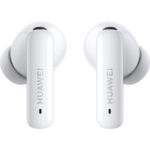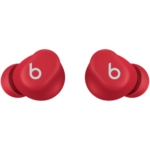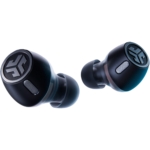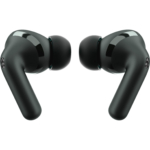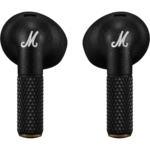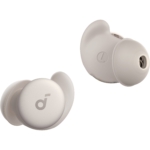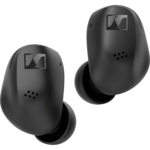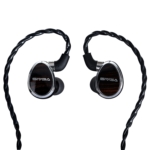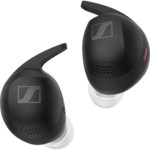The Jabra Elite 4 Active impressed us like no other model has done during sporting activities; their robust construction, including certification, and the fit of these True Wireless in-ears offer no cause for criticism. This also applies to the integration via the manufacturer’s app, which feels modern and is constantly being further developed. A few points are deducted for the active noise cancelling, which could have been used more forcefully, and for the sound. Although this should fully satisfy most people during workouts, at a price of just under 120 euros, other models in this price range offer more.
The new Jabra Elite 4 Active aim to offer a lot for a price of just under 120 euros: IP57 certification, active noise cancelling, transparency mode, good sound as well as an app connection. We’ll find out how well they work in this test.
After Jabra expanded its portfolio last year with an affordable model Jabra Elite 3 in addition to the two high-end pairs of headphones Jabra Elite 7 Pro and Jabra Elite 7 Active, their next contender has arrived. The new Jabra Elite 4 Active fits seamlessly between the Elite 3 and 7.
Key specs
The Jabra Elite 4 Active are available in black, blue or mint. The package consists of the earphones themselves (approx. 4.9 grams each), the charging case weighing just under 38 grams, three pairs of silicone ear tips (S, M, L) as well as a short USB-A to C charging cable (approx. 15 cm).
The built-in 6 mm drivers reproduce frequencies from 20 Hz to 20 kHz and support Bluetooth 5.2 as well as the codecs SBC and aptX. This is not an ideal solution if you are an iOS user because neither the iPhone nor the iPad supports the higher-quality aptX codec. You’ll have to live with the lower-quality SBC variant.
Initial pairing is quick with this model: either press both buttons on the earbuds for three seconds or, thanks to Google Fast Pair on Android smartphones, establish the wireless link directly via a corresponding pop-up. The headphones do not support multipoint, so if you want to change your player, you have to manually interrupt the current connection. Instead, the headphones automatically connect to the last active source.
In an open space, we heard the first interruptions of the wireless link after about 34 metres; inside an apartment of over 100 square metres, it only broke when we were in the basement on the opposite side of a wall to the external player – these are very good values.
Operation
Jabra handles this well: the manufacturer does without touch-sensitive surfaces on the Elite 4 Active and instead relies on classic buttons to press, so there are no accidental inputs. However, you inevitably press the small earbuds into your ear a little each time. The pressure point of the buttons could have been a little lower. But their responsiveness in connection with a Pixel 3a could have been a little higher: If you press Play/Pause too quickly (< 1.6 seconds) in succession, the Elite 4 Active does not execute the second command. Interestingly, this phenomenon does not occur when the in-ears are paired with an iPhone 8 Plus. We, therefore, do not want to blame this “flaw” on the headphones.
By pressing the surface of the left in-ear once, you can switch between the modes “ANC” and “HearThrough” (transparency mode). With Jabra’s Sound+ app, this can be extended to include the neutral position (i.e. “all off”). But more about that later. Pressing twice calls up a voice assistant or starts Spotify and plays songs that match the track currently playing. The volume can be reduced by holding down the button on the left, while the volume can be increased on the right. This is also where you navigate through the tracks: pressing once starts or stops playback, pressing twice moves one track forward, pressing three times moves one track back.
During phone calls, both sides again offer (almost) the same feature set: answer, hang up, reject, mute or unmute the microphone, and change the volume.
If you want to use the Jabra Elite 4 Active in mono mode, i.e. individually, you can, of course, do so. Simply park an earbud in the case, and without interruption, the single in-ear will continue to play; only the control options will change.
In practice
Thanks to IP57 certification, the Jabra Elite 4 Active are well protected in wind and weather and fit almost flat in the ears due to their design. During bike and running laps in dingy winter weather, we found the wearing comfort to be comfortable and, despite the pressure, pain-free even after several hours. Fortunately, there was no pressure due to slipping, but footsteps and wind noise reached the ears – if slightly reduced. Due to the fit, the earphones close tightly and therefore offer a high level of passive noise suppression. For safety reasons, the HearThrough mode should always (!) remain activated; we used it at the highest sensitivity level (see below) in all our tests.
Since the charging case has no certification, the earphones should definitely be dried thoroughly after cleaning before they go back into the charging bed.
Battery life
Jabra claims a runtime of up to seven hours on one charge, and the case can fully charge the earphones up to three times, giving 28 hours of total runtime. The manufacturer has also thought of a practical quick-charge function: An hour of additional battery life is available after just ten minutes of charging in the case. Corresponding multi-colour LEDs on the earpieces and the charging case provide information about the charging status. To conserve battery power, the headphones switch off automatically as soon as they are out of range of the player and not in the charging case for 15 minutes or if they have not been active for 30 minutes.
Jabra Sound+ App
Jabra places a lot of emphasis on the integration of their products. To this end, the modern design of the “Sound+ App” offers a range of tuning options.
This free app for iOS and Android should therefore not be missed for any device, as it allows, among other things, swapping the left double press from Spotify to Alexa or voice assistance, or activating or deactivating audio playback while using HearThrough mode. In addition, the noise-cancelling can be adjusted in nine levels, it is also possible to choose between six EQ pre-sets, make a manual change and save settings from the 5-band EQ here. Sidetone, i.e. hearing one’s own voice during a phone call, is activated by default and can also be switched on/off here. If you have misplaced your headphones, you can use “Find My Jabra” to find them again using a map and tones. The range of functions is rounded off by the option of downloading firmware updates, reading the battery status or learning about the basic functions of the headphones via a short manual.
Noise Cancellation
The noise cancelling of the Jabra Elite 4 Active can be personalised via the app, as mentioned above, in nine levels depending on the frequency. To do this, you slide the slider to the desired position, the setting is then retained and is active immediately. In our test conditions, the noise-cancelling achieved a satisfactory result for us at level 6.
Compared to the Panasonic RZ-S500W, Apple AirPods Pro or Sony WF-1000XM4, the ANC of the Jabra Elite 4 Active does not come close, but low-frequency rumble is still suppressed well, as are mid-heavy conversations, whereas the high-frequency range is lowered much less. All in all, a solid performance; if you need more, you’ll have to look to the competition.
HearThrough mode
The built-in transparency mode also works solidly. As with the noise-cancelling, Jabra’s app offers a five-step adjustment of external noise perception. However, the background noise is audibly raised – although we only really noticed this during silence or very quiet passages. The Jabra Elite 4 Active don’t achieve the naturalness of the Apple AirPods Pro here, but fortunately they don’t sound artificial like some of their competitors.
Sound
We begin in the frequency basement: the Jabra Elite 4 Active manage to reproduce low-frequency material without masking the rest of the frequency range. Despite this boost, tonalities can still be captured satisfactorily, even if we noticed inaccuracies – the low range, therefore, didn’t seem particularly striking. Extreme low bass rumbles, therefore, lack real oomph, but this can be helped by the EQ. In contrast, songs whose low bass is far less pronounced benefit from this tuning: this fullness suits funk and dance tracks of the 70s and 80s in particular, and makes for pleasurable listening.
We did not notice any distortion at high volumes, Jabra has this well under control. The transition from the upper bass to the lower mids is done well by the manufacturer, but in terms of selectivity, the Elite 4 Active could easily go a step further for our taste. The midrange, together with the tweeter, forms a successful overall picture that doesn’t come across as loud; there are no nasty electric guitars or lead synths sawing into the ear. However, we missed a certain airiness and playfulness from the drivers; fine, quiet details in overloaded music tracks are not among the strengths of this Jabra model.
Sound-wise, the Jabra Elite 4 Active remind us strongly of the cheaper Elite 3 from the same company.
For just under 120 euros, however, we would have liked to see a more “audiophile” tuning for these drivers, because in this price range they have to compete with the very good Panasonic RZ-S500W, the LG TONE Free FN7 or the slightly more expensive Soundcore by Anker Liberty 3 Pro, which all come out ahead in terms of sound.
Telephony
Jabra has also installed four microphones in the Elite 4 Active, which are supposed to ensure crystal-clear sound with little background noise. In practice, however, this is not always realised. My voice was always intelligible and natural, but typical sound effects or background noise still came through – albeit muffled – to the person we were talking to. Of course, this also depends on your network coverage: If you only have Edge, you will have to live with poorer voice transmission, whereas with 4G or even WLAN, we had no problems during video conferences. A nice solution: When making a call, your own voice can be faded in thanks to Sidetone, which allows for much more natural speech.
Technical specifications
- Ear couplingIn-ear
- Typeclosed
- Transducer principledynamic
- Frequency response (headphones)20 - 20.000 Hz
- Cable length15 cm
What's in the box
- 3 pairs of ear tips in S, M, L
- USB-A to C charging cable
- Charging case
Special features
- Available in black, blue and mint
- BT codecs: SBC, aptX
- BT version: 5.2






